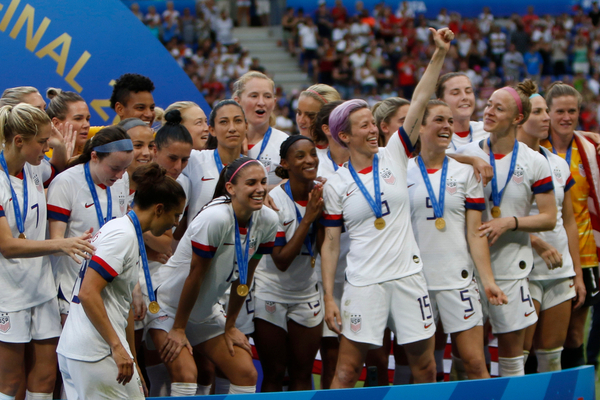The 2019 FIFA Women’s World Cup France Final on Sunday wasn’t just a soccer match. Although the undeniable strength, athleticism and spirit displayed on the pitch that day certainly took center stage, the event came to symbolize so much more because of what led up to it, including female empowerment, the fight for equal pay, LGBTQ+ rights, the legitimacy of women’s sports and, well, Nike.
The biggest sports brand in the world made a massive investment in women’s soccer this year that paid off despite its competitor, Adidas, being the official World Cup sponsor. Nike sponsored 14 of the 24 teams in the tournament, including the U.S. and the Netherlands, who won gold and silver, respectively. Throughout the tournament, more minutes were played and more goals were scored in Nike boots than in those by any other brand. Though we couldn’t actually see them (no one pulled a Brandi Chastain), we were told that all of the players on the pitch Sunday were wearing Nike sports bras as well. Nike also beat Adidas in social media mentions.
And, yes, all of that visibility is already driving sales: Nike’s USA women’s home jersey became the number-one-selling soccer jersey, men’s or women’s, ever sold on nike.com in one season; sales of women’s apparel pertaining to the tournament are up more than 150% over the last Women’s World Cup in 2015; and the exposure is also driving sales of “kits, high performance bras and lifestyle extensions,” according to data provided by the Portland, Oregon-based company.
“We can feel the World Cup’s energy and impact throughout our growing women’s business. Female athletes worldwide are engaging with sport like never before,” said Rosemary St. Clair, VP/GM, Nike Women, in a statement. “Whether it’s unprecedented sell-through on national team kits, popularity for high-performance bras, or global impressions of our campaign, we’re ecstatic about how this summer has contributed to the acceleration of our women’s offense at Nike.”
For Nike, the final game was the culmination of extensive preparation to leverage the Women’s World Cup as a marketing opportunity. The goal: to bring attention to its increased focus on its women’s business, from debuting a new range of innovative sports bras, to collaborating with four up-and-coming female designers, to unveiling another one of its inspiring, tear-jerking commercials mere minutes after the U.S. win became official.
Nike is no stranger to collaborations with buzzy fashion designers, but that it chose to work with not one, but four of them around the Women’s World Cup is a testament to how big of a priority this event was. The brand consistently invests resources in scouting potential collaborators around the world. In this case, it deliberately chose female-led, up-and-coming brands, each of which already incorporated sporty influences into their designs: Ambush’s Yoon Ahn, Koché’s Christelle Kocher, MadeMe’s Erin Magee and Marine Serre got the opportunity to put their unique spin on a national team jersey and a sports bra, with practically all of Nike’s innovation and production resources at their disposal.
“We’re looking for collaborators that bring something unique and new [to Nike],” says Julie Igarashi, VP/Creative Director of NikeWomen. “It’s fascinating to see what people do with the Nike platform and we can learn from each other. And, to give young women, emerging talent, the opportunity to partner with a brand like Nike, one of the most powerful institutions of sport in the world, that’s a big deal and we take it with a lot of responsibility and respect.”
In many ways, the World Cup was only the beginning of Nike’s efforts to both court female customers and to bring more attention to women’s sports as a whole — something it’s in the unique position to do. “As we speak, we’re creating an even deeper emotional connection to consumers through the Woman’s World Cup in France,” said Nike CEO Mark Parker during an earnings call on June 27.
Collaborations like those executed for the World Cup also help expose the sports brand’s wares, and maybe even the world of women’s soccer, to those who don’t do or follow sports, and this seems to be a big part of how Nike plans to go after women moving forward. According to Irashi, the company is also making a push to work with and highlight more female creatives, beyond fashion designers. “It’s just the beginning; we’re definitely committed to walking the talk and opening the aperture around what people think sports is and can be and bringing people in from different points of view and different experiences is really critical to that.”
—
Photo Credit: Romain Biard / Shutterstock.com
